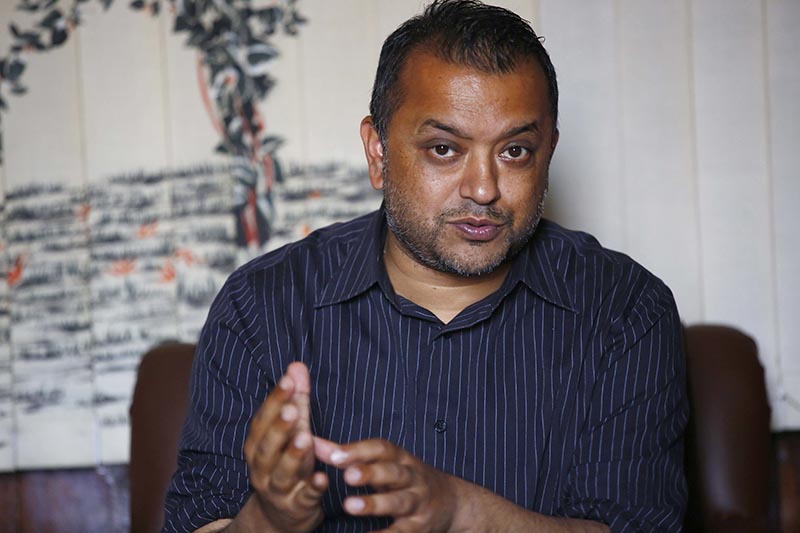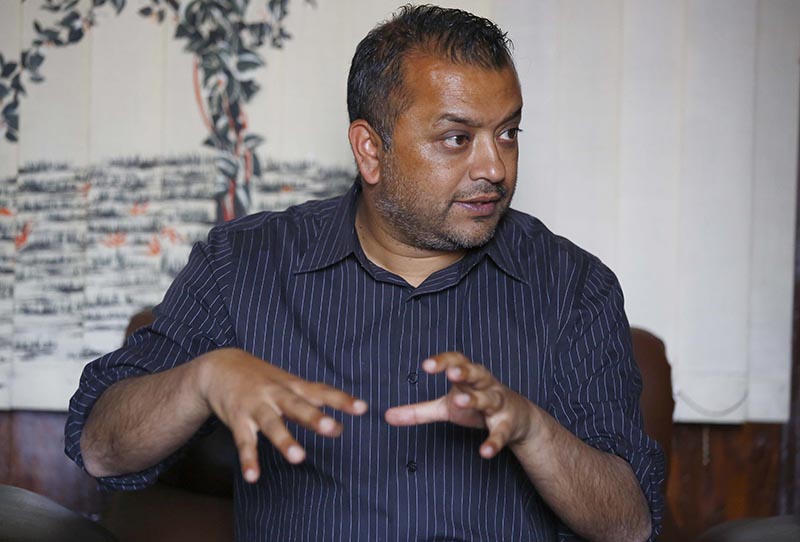Partnership with academic institutions is the key: Minister Thapa
Eight months in office as health minister, Gagan Thapa has finally got things moving, but says he is far from satisfied. He understands there is a gap between his vision and the final output. The ambitious minister has however drawn up a seven-year plan to take Nepal’s health sector to greater heights. The 40-year-old minister and his young team work hard, sometimes even 18 hours a day, to keep the health initiatives running. Arjun Poudel of The Himalayan Times caught up with Thapa at his office this week.

Excerpts of the interview:
Has your excitement evaporated since becoming health minister?
I have mixed feelings. The day-to-day management is far worse than one would have imagined. The view from the outside is that Nepal’s social sector – education and health – is in a complete mess. But that is not the case. A lot of good things have been done in the past 25 years in terms of infrastructural development and the stage has been set for further improvement. In certain aspects, Nepal is ahead of many developing countries, but we can do much better and achieve more in the days to come. When it comes to handling daily business, I find it in a state of disarray. Sometimes it is rather frustrating.
While I am excited about the initiatives that the ministry has started, I am also worried about the political scenario. I fear that if a new leadership takes charge of the health ministry, the work we initiated may be discontinued. All our effort, energy and resources invested into this will just go down the drain. I am worried because these initiatives haven’t been internalised by the system.
Is this because there is a mismatch, say, in terms of capacity, willingness and speed?
I inherited the policy, programme and budget drawn by another government when I was appointed health minister. On the one hand, you can see that the ministry has highly competent and experienced officials who can deliver what they promise; while on the other, they have ‘a set psychology’ that pulls them back from what they set out to do.
Have you had to slow down due to this ‘set psychology’?
There have been instances where expected results could not be achieved. For example, hospitals throughout the country lacked consultant doctors. I tried to manage them internally, but that was impossible because we did not have enough doctors. I sought permission from the Public Service Commission to hire consultant doctors on contractual basis. We announced vacancies to hire specialists, but the doctors did not apply. Only a few applied and they resigned when they were asked to work away from Kathmandu.
The ministry now has a long-term plan. The short-term strategy is to provide services through partnership with academic institutions: both public and private. The original schedule was to start services with effect from February 12.
The stage is now set. The strategy is ready, our policy decisions are in place and the financial resources are available. I am, however, still struggling to get things done. Partnership with medical institutions is a new concept and it is not so well-received because it is a new idea. We recently organised a major surgical camp in coordination with the Nepali Army in Rautahat. A lot of people came to the health camp for services. We would like such services to continue in Rautahat and similar facilities to be established in other parts of the country.
Can you elaborate your idea of partnership?
The fundamental idea is that the government-guaranteed service does not necessarily mean that the government itself has to deliver these services. In case the government cannot provide basic services, there are a number of modalities. For example, we can go for partnership with academic institutions, such as, teaching hospitals. We have recently signed some agreements under which these medical colleges will send their residents, who are doctors doing their post-graduate studies, and the government will pay them partially. As per the law, each resident doctor has to take up ‘community posting’ for three months, but this has never been implemented. These agreements are basically to implement this very provision. Thus, I made a strategic move. I had the Nepal Medical Council define community posting, and then got it to issue notice requiring resident doctors to take up community posting compulsorily. This means the residents will now have to work in designated government hospitals across the country. This is where the partnership agreement can help meet the demand and supply gap.
Government hospitals have been unable to provide basic services because they do not have sufficient specialised doctors. Kathmandu Medical College will provide basic services in Bardibas Hospital. Chitwan Medical College has taken charge of Nawalparasi Hospital; Nepalgunj Medical College will take care of Tikapur Hospital; Institute of Medicine has committed to deliver services in the government hospital in Rapti and Biratnagar. Likewise, Bir Hospital will deliver service in Dhading and Sarlahi.
Such initiatives have been taken and we have been working everyday.
What’s being done to improve efficiency?
We are developing an online file tracking system. Hopefully, it will be completed by mid-April. This online file tracking system is between departments within the ministry, between the health ministry and other ministries, including the Office of the Prime Minister and Council of Ministers. Once the system is developed, we do not have to physically carry files around. Some ministries have already started using this system. We have been trying to ensure that files are not held at any table for more than three working days. For the short term, we have been following up on the files manually.
What’s your focus?
I have been focusing on coordination and strategic intervention, which is basically identifying the gaps and addressing them. We are planning to start a free post-graduation course at least in five zonal hospitals from this year. If things go according to my plan, the PG programme will be launched in Koshi Zonal Hospital soon. The government will invest in the PG programme and its residents. Upon completion, the doctors will be bound by contract to provide service, at least for five years, in the same hospital. I have also made a seven-year plan to strengthen Nepal’s health system, which I am discussing with aid agencies.
I am happy that a lot of things have been done in the last two decades. I won’t be able to say we can take Nepal’s health sector to a certain height in the next seven years, if zonal hospitals are not built and we do not have the institutes.
We don’t need anything to start PG study in Koshi Zonal Hospital since the hospital under the National Academy of Medical Sciences has as many as 48 MD and MS doctors and sufficient faculty doctors. There are also thousands of patients visiting the hospital every month.
Is Nepal’s health sector ‘donor-driven’?
It would be an abstract thing to say Nepal’s health programmes are totally donor-driven. I had a meeting with the country head of the World Bank to share my seven-year plan and I explained that we were Rs 12 billion short per annum to implement my concept. They are positive about my plan and are ready to discuss it. World Bank did not come up with suggestions. The ministry should make a plan and take help from donors.
I have asked the World Health Organisation to work in three sectors – in alcohol taxation, health-in-all policy and taxation on sugary drinks.
As per the suggestions of the panel, we have been providing resources to zonal, regional and district hospitals and have asked them to purchase equipment they need to improve service quality. We have been asking donors to invest in the curative sector, in which government investment is very low.
We have a constitutional obligation to have better health care in place Our youths go to gulf countries and if they suffer renal failure that is tantamount to collateral damage. We have to work in those sectors from the social security angle. We have decided to provide free valve replacement surgery to patients suffering from rheumatic heart disease.
With just 6 per cent budgetary allocation for health, don’t you think your plan is ambitious?
Not at all, it is strategic. The logic behind providing free valve replacement surgery is that majority of patients suffering from rheumatic heart disease are youths. The government has been supporting them and if we give additional Rs 150,000, the patient will return to productive life after treatment.
The government has been providing free dialysis service to patients suffering from renal failure. The government spends about Rs 30,000 every month on each patient. If we provide free dialysis service, people will be dependent on the state. That’s why the government has offered free kidney transplant. After transplant, individuals will be working and contributing to the development of our country.
We collect over Rs one billion in tax from cigarettes. So when I asked for that money, the Ministry of Finance offered it so that I could start all these new initiatives.
What are your biggest lessons from this experience so far?
After working here for eight months, I have found that we can provide quality medicines at a price cheaper than what we offer now. For that, the government has to start buying medicines from manufacturers directly, but the Public Procurement Act does not allow us to do this. I have learnt that it takes time for results.
I also tried to improve ambulance services as there is gross misuse of most ambulances. Authorities do not have record of ambulances. I have been involved in over 50 projects like this and I have not been doing this work in a disorganised way. I have a team of about 18 people and they are an organised team of young volunteers.
Any idea about the structure of the health ministry after Nepal transitions fully into federalism?
We have a task force that holds meetings every day from 3:00pm to 5:00pm. They have been working on the structure, on what to keep in the centre, provinces and local levels.
We have taken the next seven years as transition phase and said there will be a hospital at the local level. At present, a health worker serving in a remote village hopes to get transferred to a bigger place after two years. But in federalism, the health worker will continue to work at the local level and won’t be transferred.
What can we expect in the next six months?
A lot of initiatives will materialise. Hospital pharmacies will be functional throughout the country. I have tried to open hospital pharmacies by mid-April.






